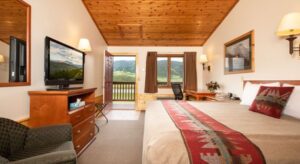Geysers Galore: Hydrothermal Features of Yellowstone
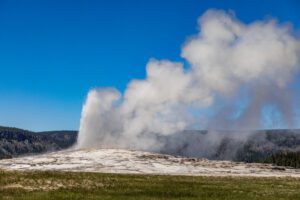
[caption id="attachment_2514" align="alignright" width="480"] Dietmar Rabich / Wikimedia Commons / “Yellowstone National Park (WY, USA), Old Faithful Geyser -- 2022 -- 2619” / CC BY-SA 4.0[/caption] A visit to Yellowstone National Park is almost certain to involve thrilling landscapes and wildlife sightings, but what really sets Yellowstone apart from the pack is the geysers and other hydrothermal features. Of course, “hydrothermal features” sounds a bit boring, but that’s only because geologists can’t take each other seriously if they call these features “hot, occasionally explodey water that comes out of the ground.” But what’s the difference between a geyser and a hot spring? Are mud pots hydrothermal? And what on earth is a fumarole? In today’s blog post, a continuation of our series on the national parks near Jackson Hole, we’ll explore all the different types of hydrothermal* features you’ll find in Yellowstone National Park.
Dietmar Rabich / Wikimedia Commons / “Yellowstone National Park (WY, USA), Old Faithful Geyser -- 2022 -- 2619” / CC BY-SA 4.0[/caption] A visit to Yellowstone National Park is almost certain to involve thrilling landscapes and wildlife sightings, but what really sets Yellowstone apart from the pack is the geysers and other hydrothermal features. Of course, “hydrothermal features” sounds a bit boring, but that’s only because geologists can’t take each other seriously if they call these features “hot, occasionally explodey water that comes out of the ground.” But what’s the difference between a geyser and a hot spring? Are mud pots hydrothermal? And what on earth is a fumarole? In today’s blog post, a continuation of our series on the national parks near Jackson Hole, we’ll explore all the different types of hydrothermal* features you’ll find in Yellowstone National Park.  Fountain Paint Pot;
Fountain Paint Pot;
Diane Renkin;
January 2012;
Catalog #20444d[/caption] © Frank Schulenburg / CC BY-SA 4.0 / WIkimedia Commons[/caption]
© Frank Schulenburg / CC BY-SA 4.0 / WIkimedia Commons[/caption]
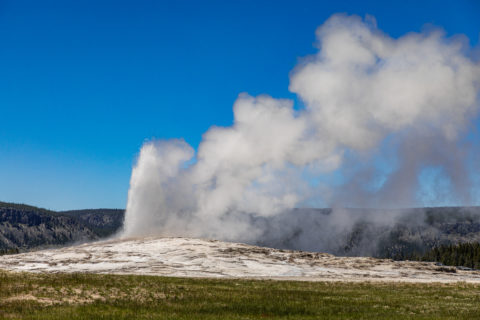 Dietmar Rabich / Wikimedia Commons / “Yellowstone National Park (WY, USA), Old Faithful Geyser -- 2022 -- 2619” / CC BY-SA 4.0[/caption] A visit to Yellowstone National Park is almost certain to involve thrilling landscapes and wildlife sightings, but what really sets Yellowstone apart from the pack is the geysers and other hydrothermal features. Of course, “hydrothermal features” sounds a bit boring, but that’s only because geologists can’t take each other seriously if they call these features “hot, occasionally explodey water that comes out of the ground.” But what’s the difference between a geyser and a hot spring? Are mud pots hydrothermal? And what on earth is a fumarole? In today’s blog post, a continuation of our series on the national parks near Jackson Hole, we’ll explore all the different types of hydrothermal* features you’ll find in Yellowstone National Park.
Dietmar Rabich / Wikimedia Commons / “Yellowstone National Park (WY, USA), Old Faithful Geyser -- 2022 -- 2619” / CC BY-SA 4.0[/caption] A visit to Yellowstone National Park is almost certain to involve thrilling landscapes and wildlife sightings, but what really sets Yellowstone apart from the pack is the geysers and other hydrothermal features. Of course, “hydrothermal features” sounds a bit boring, but that’s only because geologists can’t take each other seriously if they call these features “hot, occasionally explodey water that comes out of the ground.” But what’s the difference between a geyser and a hot spring? Are mud pots hydrothermal? And what on earth is a fumarole? In today’s blog post, a continuation of our series on the national parks near Jackson Hole, we’ll explore all the different types of hydrothermal* features you’ll find in Yellowstone National Park. Hot springs
Hot springs are the most common kind of hydrothermal feature in Yellowstone, probably because hot springs represent hydrothermal activity in its most basic form. It’s a pretty simple process: water seeps through the bedrock, where it comes in contact with heat below and then rises to the surface. This process of convection (hot water rising, cooling down, and then getting replaced by water from below) makes it so the water never gets hot enough to erupt. Which is good news for the people inevitably skinny dipping in the water. EXAMPLE: Grand Prismatic Springs may be the most photographed feature in Yellowstone. It’s a hot spring the size of a football field, glittering with rings of orange, yellow, green, and blue. It’s also deeper than a ten-story building. If you drop your keys into those superheated depths, please refrain from jumping after them. [caption id="attachment_2515" align="alignleft" width="480"]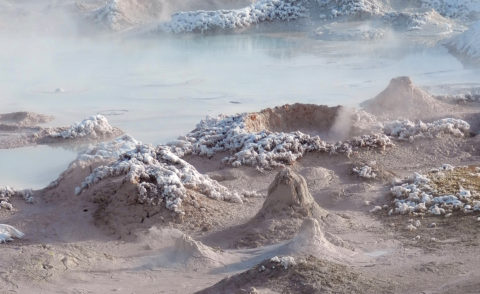 Fountain Paint Pot;
Fountain Paint Pot;Diane Renkin;
January 2012;
Catalog #20444d[/caption]
Mudpots
Still got your geology hat on? (We’re not sure what a geology hat looks like, but it’s probably pretty stylish, right?) Mudpots are a special type of hot spring. A gas called hydrogen sulfide (which is what gives mud pots their characteristic unpleasant smell) is usually present, giving tiny microorganisms something to feed on. These microbes help convert the gas to sulfuric acid, which in turn breaks down the surrounding rock into clay. The clay turns to mud, and voila! You get a gooey, gurgly sludge that smells like rotten eggs. Okay, we’re really not selling the experience very well, but it’s still worth a look. EXAMPLE: There are basically two notable locations of mud pots in Yellowstone. First, the Artist Paint Pots are about three miles south of Norris Geyser Basin. The Fountain Paint Pots can be found in the Lower Geyser Basin between Madison and Old Faithful. Both mud pots bubble various striking colors thanks to iron oxides in the goo.Fumaroles
A fumarole sounds like some sort of delicious pastry you might eat while on vacation in Europe, but we actually don’t recommend you put your mouth anywhere near one. A fumarole, or steam vent, happens when there’s heat and just a little bit of water below the surface. Most of the water boils away, leaving steam and other gases to hiss from the vents. EXAMPLE: Red Spouter is one of Yellowstone's most famous fumaroles, so called because the earth around it is red-colored and it—if you can believe it—spouts steam. [caption id="attachment_2513" align="alignright" width="480"]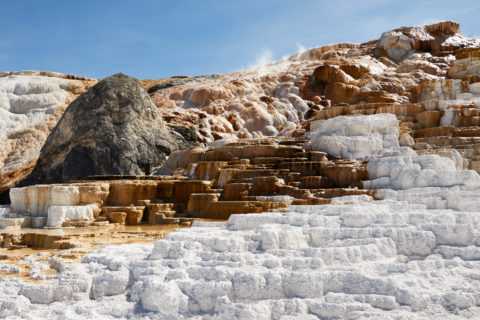 © Frank Schulenburg / CC BY-SA 4.0 / WIkimedia Commons[/caption]
© Frank Schulenburg / CC BY-SA 4.0 / WIkimedia Commons[/caption]
